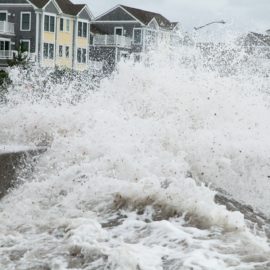
Democrats recognize the ill effects of climate change and work to help us reduce emissions. Republicans have their heads buried in the sand. The governors Climate Task Force plans will be voted on Monday by the task force and then it goes to the legislator and our legislative body is republican. What will happen?
Gov. John Bel Edwards on Friday discounted concerns that his plan to reduce the state’s carbon emissions to “net zero” by 2050 will be rebuffed by lawmakers and state utility regulators in the coming months. The governor also dismissed talk that the plan, which has drawn the ire of some industry groups, could be abandoned by his successor once his term ends in 2024. “I think you do the best you can by demonstrating how important it is, and making as much progress as you can,” Edwards said on Friday during an editorial board meeting with The Times-Picayune and the Advocate. Part of that effort is reminding policy-makers what’s at stake, he said. “We know that land loss is driven by climate change. We know that increasing severity and frequency of our natural disasters is a result of climate change, and we know that we are contributing,” Edwards said, pointing to the back-to-back Category 4 landfalls of Hurricane Laura in 2020 and Hurricane Ida in 2021.
nola.com
Because of our heavy industrial base in oil and chemicals we produce more emissions that any other state.
Edwards added that Louisiana contributes more carbon emissions per capita than any other state, largely because of its chemical manufacturing sector. According to the state plan, the state’s industrial share of emissions is actually 66%, compared to roughly 17% on average nationwide. The governor’s Climate Initiatives Task Force meets Monday morning to vote on the plan, which includes 28 proposed strategies and 84 actions that, if all adopted, would likely reshape the state’s economy. While a handful of members of the 23-member task force have balked at one or more of the proposed actions, the plan is expected to be approved with no changes on Monday.
The plans aim to reduce our emissions by various means.
The moves would result in a shift to renewable power generation such as solar and wind power, which would then be used to power the state’s massive industrial base. The plan also requires industries that use high-intensity heat processes to switch from carbon-based fuels to hydrogen. Still, Edwards said Louisiana’s position as a traditional producer of oil and natural gas will not change for many years. “But there is a definite transition underway,” he said. “And if you don’t transition, then you’re going to get down the road not too very far, and it’s going to be a dead-end road. And nobody should think that that’s in our state’s best interest.” The state’s industrial base already is leading that transition, he said, as seen by numerous recent announcements of new manufacturing facilities that rely on carbon reduction, carbon replacement and capturing and sequestering carbon emissions underground. “And so it’s my hope that we move this far enough down the field that nobody who comes behind me – regardless of what their philosophy is today – would think it’s a good idea to move away from that,” Edwards said. The governor also dismissed concerns that a state emphasis on renewable resources would result in other states, such as Texas, becoming more competitive for new industrial projects. He said companies, seeing the writing on the wall, have already begun moving toward a greener future.
Wind power is the issue in the news now and Louisiana is looked as the first Gulf state for getting them.
An example of that is the expected interest in a first-ever lease sale for wind power in the Gulf of Mexico by the federal Bureau of Ocean Energy Management later this year, he said. “And so it’s actually going to make us more competitive, not less competitive,” Edwards said. Getting to the “net zero” carbon emissions goal Edwards set in a 2020 executive order will require major technological advances to be developed over the next decade, he acknowledged, especially to meet the plan’s goal for the use of “green” hydrogen made without carbon fuels. But today’s industries can already take advantage of federal tax breaks to help them pay for another one of the plan’s controversial strategies — using “carbon capture and sequestration” projects to permanently store carbon dioxide gas underground, Edwards said. Those tax credits will increase to $50 per metric ton of carbon dioxide properly sequestered underground by 2026, which would help offset the cost of sequestration projects.
Sequestration is being considered here but there are still questions on how effective it will be.
Sequestration in Louisiana would require drilling a well to as much as 10,000 feet below the surface and injecting carbon dioxide under pressure. At that depth, the gas heats up and turns into a liquid-like state, which in theory should help it stay in place in saltwater aquifers at that depth. The process is controversial, though, and recent reports have questioned its long-term success in keeping the all of the injected carbon from entering the atmosphere. Edwards said that despite those reports, “we do believe in the technology,” citing President Joe Biden’s administration’s support for it and several industries’ recently announced plans to use it to reach net zero levels.
We also need more infrastructure for distributing the energy as well as electric vehicle charging stations.
The state’s proposals to develop alternative electricity sources will require major upgrades to the electric transmission grid. So too must small solar power networks be developed for neighborhoods, steps that are aimed at improving reliability after hurricanes or other power-killing events. The plan also calls for a dramatic buildout of charging stations for electric vehicles, to meet the expected demand from electric cars and trucks expected in the near future. The state would lead the way by replacing its existing vehicle fleet with electric vehicles.
The governor is setting up an administrative format to oversee all the changes desired.
A team within the governor’s office would also be tasked with overseeing implementation, and each government agency would be expected to dedicate some of its employees to climate initiative work, Edwards said. He also said the task force’s term won’t expire on its adoption of the plan. Similar to the methods used to update the state’s Master Plan for hurricane risk reduction and coastal restoration, the carbon reduction plan will be updated every several years, based on updated inventories of the state’s greenhouse gas emissions.
Now the rubber is hitting the road with the Climate Task Force vote and then moving to the House. Two crucial votes.



